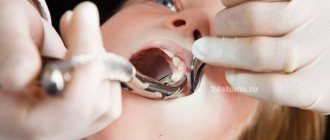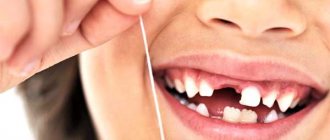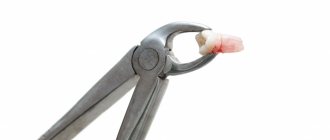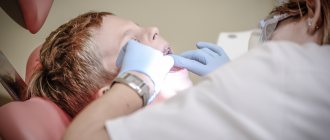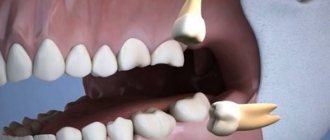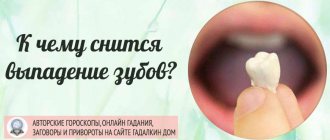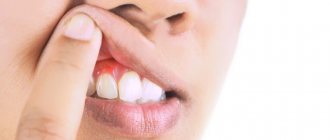The condition when a child is growing a tooth, but the baby tooth has not yet fallen out, is also called “shark teeth” - the primary and molar teeth are located in two rows, which resembles the bite of this marine predator.
But is this always a problem that requires surgical removal of “old” teeth, or can we wait for the situation to resolve itself? Therefore, we will next consider what to do if a permanent tooth grows behind a milk tooth!
Causes
In most cases, when a permanent tooth grows behind a milk tooth, the problem develops due to insufficient chewing load on the teeth. Today, the average child’s diet can be described as refined!
The main part of the daily diet consists of thermally or mechanically processed food, which does not require the child to make efforts to grind it with his teeth.
Parents often believe that by eating this way they are, on the contrary, taking care of their baby’s teeth, and this will allow them to remain healthy for as long as possible. But chewing is a natural and very important function that ensures the health of the entire dental system.
While chewing food, pressure is exerted on the periodontium - the musculoskeletal system of the teeth, stimulating blood circulation and the supply of nutrients. Without this, the growth of baby teeth may be disrupted and their abnormal replacement by permanent ones may develop.
A more rare reason that a child has double rows of teeth is scarring of the gums in the area of the baby teeth. This may be a consequence of mechanical injury, thermal or chemical burn.
In this case, the connective tissue, which is a scar, begins to play the role of an additional “ligament” that firmly holds the tooth in the gum.
Elimination of anomaly
Treatment of retention is a rather complex process that requires qualified assistance from dentists of several specializations. Treatment is selected individually for each patient and depends on the clinical picture of the oral cavity. The first question that a dentist needs to decide is whether to remove or save a diseased tooth. There are several treatment methods, most often this is a surgical intervention in which a specialist cuts the gingival hood so that nothing prevents the tooth from erupting outward. Surgical procedures of this kind are used in situations where the tooth grows correctly and does not interfere with neighboring teeth. In other cases, most often, the tooth is removed. Removing an impacted tooth is a rather difficult operation. The procedure is carried out under local anesthesia, after which the gum is cut, and the specialist uses a bur to create access to the tooth, after which it is completely removed. Then a special medicine is placed into the tooth socket. If necessary, sutures are applied and removed ten days after the procedure. Swelling may occur after removal of an impacted tooth. Most often, after removing such a tooth, the doctor prescribes antibiotics and painkillers. Also, the patient, for the first few days, needs to stop eating solid foods, hot and cold foods and drinks.
Possible complications
Teeth growth, even when it proceeds normally, is a rather painful and unpleasant process. It is even more uncomfortable when it is broken. In a child, “double” teeth negatively affect articulation, and if this continues for a long time, incorrect diction can become permanent.
In addition, in children with impaired chewing (and this is what discomfort due to abnormal positioning of teeth leads to), aerophagia is often observed - swallowing a large amount of air along with food.
The child, not being able to chew food normally, simply swallows it in large pieces, and with it, air. The result of this can be dyspepsia, flatulence, and even underweight - the air in the stomach creates the illusion of fullness, and the child is regularly malnourished.
Among dental complications, the most common is an increased risk of caries. When a child grows a tooth next to a baby tooth, this greatly complicates the quality of teeth cleaning, and a constant accumulation of plaque and bacteria forms between temporary and permanent teeth.
Therefore, often a delay in seeing a doctor leads to the fact that, having removed a baby tooth, the doctor sees an active and already pronounced carious process on the root (milk caries).
How many primary and molar teeth does a person have?
In children, the size of the jaw is almost half (in terms of the number of teeth that fit on it) smaller than in adults. Initially, the child has up to 20 teeth - 10 on each jaw. That is, one jaw - 4 incisors, 2 canines and 4 molars. Primary molars have not yet been clearly divided into small and large.
After 16 years, a teenager’s jaws reach approximate sizes that are accessible to an adult. A teenager already has approximately 28-30 teeth, and not 20-24, as before. The number of molars is often represented by 2 small molars and 2 large molars - on each side on each jaw. The last 2 or 4 teeth - “wisdom teeth” usually appear by the age of 20-22 - and a person acquires a full set of teeth, numbering 8 incisors, 4 canines, 8 small molars and 12 large molars - on both jaws in total.
When to see a doctor?
It is generally accepted that the “paired” arrangement of teeth can be normal if this lasts no more than 2-3 months. After a baby tooth falls out, the molar gradually changes its position and after a few months takes the correct position.
Watch the video:
Therefore, if a new tooth has just begun to grow, and the old one is still firmly in the gum, you can simply monitor the situation for several weeks and monitor the quality of oral hygiene.
But in some cases, you cannot hesitate to see a doctor. Be sure to make an appointment with your pediatric dentist if you experience one or more of the following symptoms:
- The child complains of pain and severe discomfort in the mouth, or you see some signs that this arrangement of the teeth greatly interferes with him (he began to eat poorly, “chokes” while eating, etc.).
- The baby tooth has not started to loosen over time and sits very firmly in the gum.
- The child's mouth has an unpleasant odor.
- The child has a predisposition to malocclusions or dental deformations (he has already been treated for temporary occlusion disorders, one of the parents had impaired tooth growth or their location in the dentition).
The listed circumstances may indicate the occurrence of dental problems that require immediate treatment.
What to do?
Before you understand what needs to be done if baby teeth have not fallen out, you need to understand in general terms how the replacement process occurs, what its features are and when it’s time to start sounding the alarm. In fact, the change begins long before the moment of loosening. At about the age of 4 years, the roots begin to gradually dissolve. The process lasts about 2 years, so by the age of 6 the teeth no longer have anything to hold on to the jaw and they are pushed out.
Before the age of 10, a child will lose two pairs of upper and lower incisors, as well as first molars. From 10 to 11 years old, the upper and lower canines change. The last to fall out are the large molars. All the child’s suffering ends, as a rule, at the age of 14, and the residual bite is formed at the age of 16-18. Changes occur most often in this order, but such dates are more conditional than mandatory. If the teeth fell out in a different order or the timing has shifted a little, it’s okay.
There are several reasons why a child’s baby teeth did not fall out on time. First of all, parents need to remember the moment of teething. If a baby’s first teeth appear around 8-10 months, it is not at all surprising that they will also fall out late, creating problems for their native brothers. It is also important to consider the issue of heredity. Remember when your baby teeth fell out and how your permanent teeth appeared. Perhaps you will be able to trace some pattern.
The opposite situation also happens, when new permanent teeth begin to appear prematurely at the age of 4-6 years; accordingly, they grow behind the milk teeth, on the inside of the jaw. This anomaly is called “shark teeth”. Sometimes a child may grow a whole second row. Such failures can be triggered by frequent infectious diseases or programmed at the genetic level.
If you notice such a defect in your child, show it to the dentist, although in this case doctors recommend not to panic and leave everything as it is. At the right time, baby teeth will fall out, and new molars will move into their designated place. However, it is still important to keep the process under control and undergo periodic examinations by a pediatric dentist.
If you notice that there is a splinter or fragment of a root that has not completely resolved in the jaw, also seek help from a dentist. Often it is necessary to mechanically remove the remaining fragment that interferes with the new molar and massage the gum so that growth proceeds in the right direction.
Treatment methods
If a molar grows in front of or behind a baby tooth, the doctor decides what to do in this situation only after a personal examination. To choose the right treatment tactics, the age of the child is important, how firmly the baby tooth is fixed in the gums and how much the molar has already grown, whether the child has other dental anomalies or diseases that could be the source of this problem, etc.
Based on the results of the examination, a decision may be made to remove the baby tooth or to continue observation. We recommend that you learn more about the removal of baby teeth here:
Removal of a baby tooth in a child: indications, consequences
In the first case, the child is given local or mask anesthesia and the baby tooth is extracted. After this, a visit to the doctor is scheduled at a certain frequency - it is important to monitor the dynamics of the movement of the permanent tooth into the dentition, and if this process is not observed or it is too slow, orthodontic treatment may be required.
In non-advanced cases, it is usually sufficient to wear a trainer selected according to the individual parameters of the child’s dental system. This device creates the necessary tension in the teeth, which “forces” them to move into the desired position.
Recommendations
- Pay special attention to your baby's nutrition. It is very important that his diet contains a sufficient amount of digestible calcium.
- Teach your child to maintain oral hygiene from an early age.
- An orthodontic type pacifier can be used.
- In order for the baby to form a correct bite, it is necessary not to allow him to suck his finger or chew a pencil. In addition, by such actions the child can introduce an infection into the oral cavity.
Now you know what to do if your baby teeth fall out and your molars don’t grow. After reading the article, you realized that the delay in timing can be explained by the individual characteristics of your baby’s body, and not necessarily by a pathological process. Do not forget about the factors that can cause acquired or congenital adentia and try to avoid them. If your baby’s health makes you think about going to the doctor, don’t delay it so as not to cause harm through inaction. Be healthy!
Prevention of abnormal tooth growth
To prevent dental growth abnormalities, it is important to follow a few simple recommendations:
- A child's diet should always include fresh and tough vegetables and fruits that require active and prolonged chewing.
- For any gum injuries, it is important to consult a doctor and receive treatment that reduces the likelihood of scarring and tissue hyperplasia.
- It is important to adhere to age norms regarding bottle feeding. Already at the age of 1 year, he should try to eat from a spoon and drink from a cup himself or do this with the help of his parents, and the number of bottle feedings should gradually be reduced to zero.
If you identify any complaints, symptoms, anomalies or abnormalities, promptly contact your dentist to stop the development of complications.
How to help a child?
To reduce the inflammatory process, doctors recommend using at home solutions for rinsing the mouth based on medicinal herbs (chamomile, calendula, sage, oak bark).
To prepare the decoction you will need 1 tbsp. a spoonful of dry ingredient and a glass of hot water (150 ml). Place the herb in a glass, leave for 8-10 minutes and strain. Irrigate the oral cavity with the prepared infusion after meals 2-3 times during the day.
If your child does not like the taste of the herbal infusion, there is another option - a solution based on sea salt or regular soda.
As homeopathic medicines, it is allowed to use Dentokid tablets or gel for local application from the same manufacturer.
During the period of changing baby teeth, parents should carefully monitor the quality of daily oral hygiene. The brush should have soft bristles so as not to injure the delicate mucous membrane.
Nutrition should also not be left unattended. It is necessary to include foods rich in calcium in a child’s diet in sufficient quantities to form healthy enamel.
